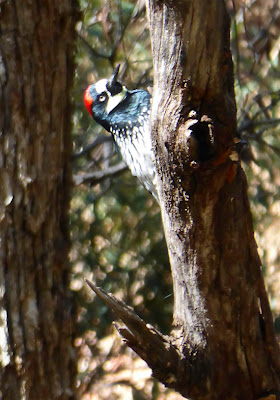We've had a full week! Many friends who know the Sky Islands choose the late monsoon season to visit, when hummingbirds are streaming south, nectar-feeding bats cluster around the feeders, and masses of clouds keep the temperatures just about perfect. (Of course the gnats find the temperature perfect too!)
South Fork, singed trees and all, has been the site of much trogon activity this week! (Photos by Narca)
Diminutive Buff-breasted Flycatcher along the Herb Martyr Road
Jon Dunn, our good friend of several decades (!––How can it have been so long?), is in town with his WINGS group, and yesterday I joined them for a fine day in the field. We wandered down Herb Martyr Road, where flash floods the day before had brought new debris across the road, and had also cut a new trench at the Crystal Cave wash, though it was manageable in the big van with its high clearance. After Herb Martyr and a stop at Southwest Research Station for the hummingbird show, we continued to the barricades at East Turkey Creek––the current site for anyone undertaking The Great Mexican Chickadee Quest. The higher Chiricahuas are still closed due to danger from the big Horseshoe Two burn and associated flash flooding.
The day brought many highlights:
We did find a Mexican Chickadee, albeit only one, and not terribly cooperative. Today Jon and friends will make a second try for better looks at The Chickadee. The Chiricahuas are the only accessible locale in the States to find this prize. They also live in a mountain range in the bootheel of New Mexico, but that is on private land and access is difficult, even on the very rare occasions when permission can be obtained.
One of the fledgling Northern Goshawks was broadcasting his wish for a meal. Jon spotted the bird in a pine not far away, and several enjoyed scope views of the youngster before he moved higher up the ridge.
Montezuma Quail covey (Detail from watercolor by Narca)
Returning, one of our folks spotted a male Montezuma Quail, standing stockstill on a rock, not 20 feet from the road. From inside the van, we scrutinized the place until several more of these cryptic birds revealed themselves. It was a family group––a gorgeous pair of adults with about six half-grown chicks in tow.
Acorn Woodpecker at Jackie's feeders in Paradise
After a stop at Jackie and Winston's feeders in Paradise (Juniper Titmouse––
yes!), we headed back to Portal. Along the way, a richly-colored Blacktail Rattlesnake decided that the big white van was definitely suspect, and a shower of sound cascaded from its rattles as we photographed the beauty.
Black-tailed Rattlesnake decides that the van isn't trustworthy.
The evening finale brought great views of a little Western Screech Owl and the swooping mass of nectar-feeding bats that visit our hummingbird feeders each night at this time of year. The nearly full moon illumined drifts of cloud in the deep night sky.
























